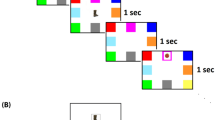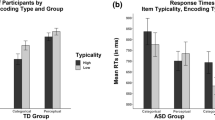Abstract
This study investigated semantic and episodic memory in autism spectrum disorder (ASD), using a task which assessed recognition and self-other source memory. Children with ASD showed undiminished recognition memory but significantly diminished source memory, relative to age- and verbal ability-matched comparison children. Both children with and without ASD showed an “enactment effect”, demonstrating significantly better recognition and source memory for self-performed actions than other-person-performed actions. Within the comparison group, theory-of-mind (ToM) task performance was significantly correlated with source memory, specifically for other-person-performed actions (after statistically controlling for verbal ability). Within the ASD group, ToM task performance was not significantly correlated with source memory (after controlling for verbal ability). Possible explanations for these relations between source memory and ToM are considered.
Similar content being viewed by others
Notes
A number of participants (23 with ASD, 6 comparison) gave perseverative responses to the recognition or source components of the memory test (i.e., provided the same response to more than 90% of questions). The mean (SD) verbal mental age (VMA), chronological age (CA), and verbal IQ (VIQ) of the participants with ASD who gave perseverative responses was 5.91 (1.45), 10.27 (3.38), and 66.96 (18.19), respectively. The mean (SD) VMA, CA and verbal IQ of the comparison participants who gave perseverative responses was 4.48 (1.45), 7.03 (5.53), and 83.83 (33.13), respectively. Because the performance of these individuals would not have been a fair reflection of their item or source memory ability (but rather their executive difficulties), these individuals were excluded from the sample.
Following the suggestion of Dr Chris Jarrold, who reviewed this paper, we also tried an alternative method of determining false-alarm-rates. Specifically, half of the distractors were arbitrarily assigned to be “self-distractors” and half to be “other-distractors”, and then separate false-alarm-rates were calculated. The data were re-analysed using these “self” and “other” false alarm rates, but the pattern of results did not differ from those presented in the main body of the paper.
References
American Psychiatric Association. (2000). Diagnostic and statistical manual of mental disorders (DSM-IV-TR) (4th ed.). Washington DC: American Psychiatric Association.
Baron-Cohen, S., Leslie, A. M., & Frith, U. (1986). Mechanical, behavioural and intentional understanding of picture stories in autistic children. The British Journal of Developmental Psychology, 4, 113–125.
Bayen, U. J., Murnane, K., & Erdfelder, E. (1996). Source discrimination, item detection and multinomal models of source monitoring. Journal of Experimental Psychology: Learning, Memory, and Cognition, 22, 197–215. doi:10.1037/0278-7393.22.1.197.
Bennetto, L., Pennington, B., & Rogers, S. J. (1996). Intact and impaired memory functions in autism. Child Development, 67, 1816–1835. doi:10.2307/1131734.
Boucher, J., & Bowler, D. (2008). Memory in autism: Theory and evidence. Cambridge: Cambridge University Press.
Bowler, D. M., Gardiner, J. M., & Berthollier, N. (2004). Source memory in adolescents and adults with Asperger’s syndrome. Journal of Autism and Developmental Disorders, 34, 533–542. doi:10.1007/s10803-004-2548-7.
Bowler, D. M., Gardiner, J. M., & Gaigg, S. B. (2007). Factors affecting conscious awareness in the recollective experience of adults with Asperger’s syndrome. Consciousness and Cognition, 16, 124–143. doi:10.1016/j.concog.2005.12.001.
Bowler, D. M., Gardiner, J. M., & Grice, S. J. (2000). Episodic memory and remembering in adults with Asperger syndrome. Journal of Autism and Developmental Disorders, 30(4), 295–304. doi:10.1023/A:1005575216176.
Brownell, R. (2000). Expressive one-word picture vocabulary test. Novato, CA: Academic Therapy Publications.
Donaldson, W. (1992). Measuring recognition memory. Journal of Experimental Psychology: General, 121, 275–277. doi:10.1037/0096-3445.121.3.275.
Dunn, L. M., Dunn, L. M., Whetton, C., & Burley, L. (1997). British Picture Vocabulary Scale (2nd Ed.). Windsor: NFER-Nelson.
Engelkamp, J. (1998). Memory for actions. Hove: Psychology Press.
Farrant, A., Blades, M., & Boucher, J. (1998). Source monitoring by children with autism. Journal of Autism and Developmental Disorders, 28, 43–50. doi:10.1023/A:1026010919219.
Gaigg, S. B., Gardiner, J. M., & Bowler, D. A. (2008). Free recall in autism spectrum disorder: The role of relational and item-specific encoding. Neuropsychologia, 46(4), 983–992. doi:10.1016/j.neuropsychologia.2007.11.011.
Hala, S., Rasmussen, C., & Henderson, A. M. E. (2005). Three types of source monitoring by children with and without autism: The role of executive function. Journal of Autism and Developmental Disorders, 35, 75–89. doi:10.1007/s10803-004-1036-4.
Happé, F. (1995). The role of age and verbal ability in the theory of mind task performance of subjects with autism. Child Development, 66, 843–855. doi:10.2307/1131954.
Hare, D. J., Mellor, C., & Azmi, S. (2007). Episodic memory in adults with autistic spectrum disorders: Recall for self- versus other-experienced events. Research in Developmental Disabilities, 28, 317–329. doi:10.1016/j.ridd.2006.03.003.
Hashtroudi, S., Johnson, M. K., & Chrosniak, L. D. (1989). Aging and source monitoring. Psychology and Aging, 4, 106–112. doi:10.1037/0882-7974.4.1.106.
Hill, E. L., & Russell, J. (2002). Action memory and self-monitoring in children with autism: Self versus other. Infant and Child Development, 11, 159–170. doi:10.1002/icd.303.
Hobson, R. P. (1990). On the origins of self and the case of autism. Development and Psychopathology, 2, 163–181. doi:10.1017/S0954579400000687.
Hurlburt, R. T., Happé, F., & Frith, U. (1994). Sampling the form of inner experience in three adults with Asperger syndrome. Psychological Medicine, 24, 385–395.
Johnson, M. K., Hashtoudi, S., & Lindsay, D. S. (1993). Source monitoring. Psychological Bulletin, 114, 3–28. doi:10.1037/0033-2909.114.1.3.
Lind, S. E., & Bowler, D. M. (2008). Episodic memory and autonoetic consciousness in autism spectrum disorders: The roles of self-awareness, representational abilities, and temporal cognition. In J. Boucher & D. Bowler (Eds.), Memory in autism: Theory and evidence (pp. 166–187). Cambridge: Cambridge University Press.
Lind, S. E., & Bowler, D. M. (in press). Language and theory of mind in autism spectrum disorder: The relationship between complement syntax and false belief task performance. Journal of Autism and Developmental Disorders. doi:10.1007/s10803-009-0702-y.
Millward, C., Powell, S., Messer, D., & Jordan, R. (2000). Recall for self and other in autism: Children’s memory for events experienced by themselves and their peers. Journal of Autism and Developmental Disorders, 30, 15–28. doi:10.1023/A:1005455926727.
Minshew, N. J., Goldstein, G., Muenz, L. R., & Payton, J. (1992). Neuropsychological functioning in non-mentally retarded autistic individuals. Journal of Clinical and Experimental Neuropsychology, 14, 749–761. doi:10.1080/01688639208402860.
O’Shea, A. G., Fein, D. A., Cillessen, A. H. N., Klin, A., & Schultz, R. T. (2005). Source memory in children with autism spectrum disorders. Developmental Neuropsychology, 27, 337–360. doi:10.1207/s15326942dn2703_3.
Perner, J. (2000). Memory and theory of mind. In E. Tulving & F. I. M. Craik (Eds.), The Oxford handbook of memory (pp. 297–312). Oxford: Oxford University Press.
Perner, J., Kloo, D., & Gornik, E. (2007). Episodic memory development: Theory of mind is part of re-experiencing experienced events. Infant and Child Development, 16, 471–490. doi:10.1002/icd.517.
Perner, J., Leekam, S., & Wimmer, H. (1987). Three-year-olds’ difficulty with false belief: The case for a conceptual deficit. The British Journal of Developmental Psychology, 5, 125–137.
Powell, S. D., & Jordan, R. R. (1993). Being subjective about autistic thinking and learning to learn. Educational Psychology, 13, 359–370. doi:10.1080/0144341930130312.
Roberts, K. P., & Blades, M. (1998). The effect of interacting in repeated events on children’s eyewitness memory and source monitoring. Applied Cognitive Psychology, 12, 489–503. doi:10.1002/(SICI)1099-0720(199810)12:5<489::AID-ACP535>3.0.CO;2-#.
Russell, J. (1996). Agency: Its role in mental development. Hove: Erlbaum.
Russell, J., & Jarrold, C. (1999). Memory for actions in children with autism: Self versus other. Cognitive Neuropsychiatry, 4, 303–331. doi:10.1080/135468099395855.
Tager-Flusberg, H., & Joseph, R. M. (2005). How language facilitates the acquisition of false beliefs in children with autism. In J. W. Astington & J. A. Baird (Eds.), Why language matters for theory of mind. Oxford: Oxford University Press.
Toichi, M. (2008). Episodic memory, semantic memory and self-awareness in high-functioning autism. In J. Boucher & D. Bowler (Eds.), Memory in autism: Theory and evidence (pp. 143–165). Cambridge: Cambridge University Press.
Wheeler, M., Stuss, D., & Tulving, E. (1997). Towards a theory of episodic memory: The frontal lobes and autonoetic consciousness. Psychological Bulletin, 121, 331–354. doi:10.1037/0033-2909.121.3.331.
Williams, D. M., & Happé, F. (in press). What did I say? versus What did I think?: Attributing false beliefs to self amongst children with and without autism. Journal of Autism and Developmental Disorders. doi:10.1007/s10803-009-0695-6.
Williams, D., & Happé, F. (2009). Pre-conceptual aspects of self-awareness in autism spectrum disorder: The case of action monitoring. Journal of Autism and Developmental Disorders, 39, 251–259. doi:10.1007/s10803-008-0619-x.
World Heath Organization. (1993). International classification of mental and behavioural disorders: Clinical descriptions and diagnostic guidelines (Vol. 10). Geneva: World Heath Organization.
Acknowledgments
We would like to thank the following schools for their participation in this research: Bensham Manor, Brent Knoll, Hillingdon Manor, Kilmorie, Linden Bridge, Southmead, Pendragon, St. Winifred’s, The Park, and West Wimbledon. We are extremely grateful to Dr David Williams for his helpful suggestions during the preparation and revision of this manuscript. Finally, we wish to thank Dr Chris Jarrold and the other anonymous reviewers of this article for their insightful comments.
Author information
Authors and Affiliations
Corresponding author
Additional information
This research was supported by a City University PhD Studentship awarded to the first author. This manuscript was prepared during an Autism Speaks Postdoctoral fellowship awarded to the first author by Autism Speaks.
Rights and permissions
About this article
Cite this article
Lind, S.E., Bowler, D.M. Recognition Memory, Self-Other Source Memory, and Theory-of-Mind in Children with Autism Spectrum Disorder. J Autism Dev Disord 39, 1231–1239 (2009). https://doi.org/10.1007/s10803-009-0735-2
Received:
Accepted:
Published:
Issue Date:
DOI: https://doi.org/10.1007/s10803-009-0735-2




